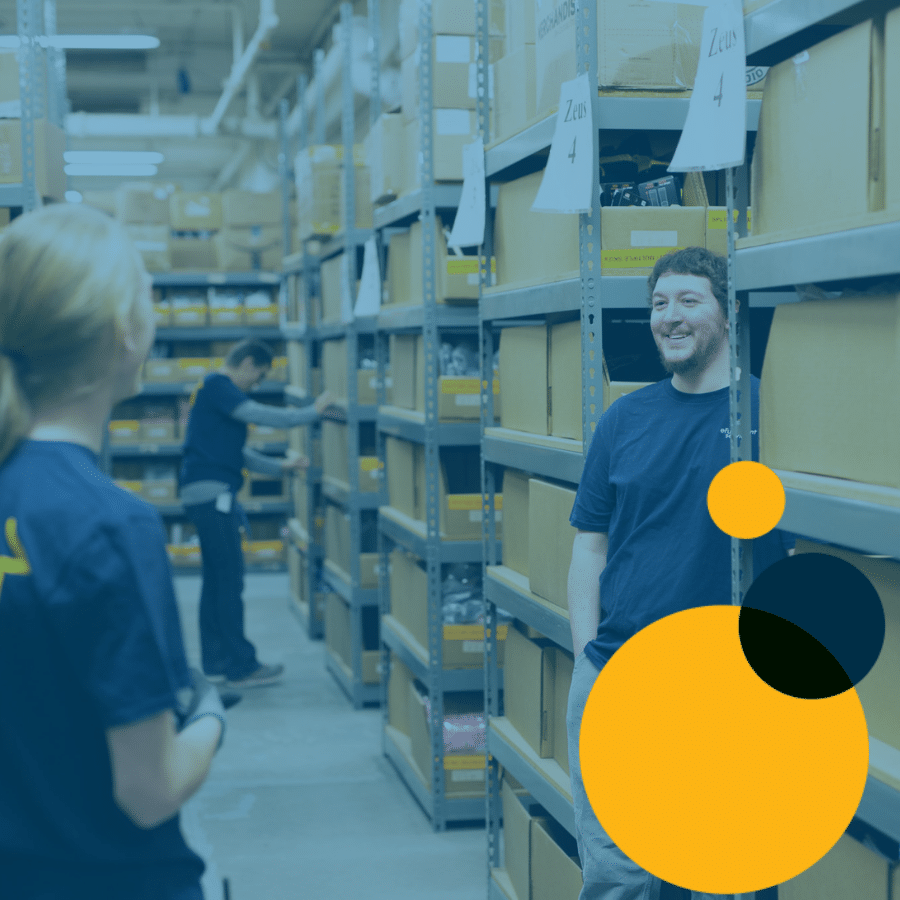
The new year brings a fresh start and many use that opportunity to set goals and redefine their lives … setting New Year’s resolutions. Of course, there’s a top-ten list of the most popular personal New Year’s resolutions (check out the graphic), all predictable in their popularity. Here are the top 10 order fulfillment tips for 2021 that we’ll cover in this article:
Top Personal New Year’s Resolutions:
1. Exercise more
2. Lose weight
3. Get organized
4. Learn a new skill
5. Live life more fully
6. Save money
7. Quit smoking
8. Spend more time with family & friends
9. Travel more
10. Read more
As we reviewed our year at eFulfillment Service through a filter of these resolutions, we noted trends that our clients, ecommerce entrepreneurs from start-ups to seasoned global leaders, can apply to their 2021 business plans to help them grow and succeed. Some of these resolutions are directly related to practices in distributing online orders, and some are benefits of working with professional distribution service centers and warehouses.
(Please forgive us for the questionable puns that follow.)
1. Exercise Manufacturing Muscles
From widespread global shifts to 2-inch box-size changes at Amazon, online retailers can no longer safely allow a single source for manufacturing to dominate production, especially if it’s in China.
In the last several years, politics and the pandemic have forced businesses into diversifying manufacturing suppliers overseas. Ecommerce sellers no longer rely on China for manufacturing. Whether they learned from having to react to tariffs or shutdowns in Chinese factories suffering from the pandemic, an uninterrupted supply line now encourages internet retailers to find manufacturers in multiple geographies, spreading the wealth and the risk. Additionally, they actively define standards across all of these new vendors defining packaging, shipping and kitting standards.
A small change in Amazon’s regulations will probably have global ripples: cartons received at Amazon must now be 25 inches (64 cm) or less on every side, reducing accepted box sizes by 2 inches (5 cm). To avoid re-boxing fees, or delays in restocking at Amazon, internet retailers need to communicate with manufacturers and have inventory packed in smaller boxes.
Manufacturing Specifications Guide for Online Retailers:
- SKUs should be sorted so that there is only one SKU per bag or carton
- Inventory cartons should be 25 inches (64 cm) or less, on every side
- Inventory cartons should weigh less than 40 lbs (18 kg) when possible
- No plastic or damaged pallets
- Pallets should be measure 40 inches wide x 48 inches deep (102 cm x 122 cm)
- Pallets should be loaded 54 inches (137 cm) high or less
- SKUs should be labeled with a scannable barcode, with data that matches your fulfillment center’s inventory systems
- Maintain a consistent company name across the Advance Shipment Notice, Shipping Label, Packing List, and your fulfillment center’s inventory systems
Ecommerce Definition: SKU or Stock Keeping Unit: In ecommerce a SKU is a stock keeping unit, or a single type of product for sale. The specifications of that product are unique, for example: the color or size distinguishes it from other color and size combinations of the item. A butterfly t-shirt might come in two colors, pink and blue. Each color has 3 sizes: small, medium and large. So there are a total of six SKUs, one for each color and size combination. One butterfly SKU is the pink, size small; another is the pink size large and a third is the blue, size small, and so on. In ecommerce, each SKU has a unique label and code that helps keep track of it, and identify the SKU in inventory, orders and shipments.
2. Lose Inventory Weight
Overall order volume for 2020 was up 40% in 2020 for eFulfillment Service. Initially, ordering trends were strongly influenced by new sanitation, health and pandemic-shutdown induced entertainment needs. Growth in online order volume was dominated by cleaning supplies, vitamins and supplements, home gym equipment and arts, crafts, books and puzzles. It didn’t take long for online ordering convenience and safety to reach every category of modern life, including apparel, electronics, toys, pantry items, house wares, home decor, pet supplies, cosmetics—you name it, it was selling.
So if a SKU wasn’t selling, then there must be a reason, and storing it is costing you money. Apply the philosophy of Marie Kondo, author of “The Magic of Tidying Up”, and ask yourself, “Is this SKU sparking sales joy?” If not, thank it for its service and let it go … donate, pitch or gift your slow moving, damaged or expired inventory, now. You’ll see savings on your very next invoice.
Also consider taking a fast, hard look at the inventory you have at Amazon. With the seasonal gift-buying peak over, you may have excess inventory at Amazon. Don’t wait for the removal order, or your inventory might be stuck in Amazon’s backlog with everyone else. Plus, you can’t sell it from any other marketplace until you get it inventoried with a fulfillment center.
eFulfillment Service ships millions of orders, affecting communication and service from FedEx, DHL and USPS. As a client, you benefit from all of that.
3. Get Fulfillment Communications & Tech Organized
The adage, “A stitch in time, saves nine,” applies to more than holes in your socks and sweaters. Your grandmother knew that if you stitched up a small hole, that kept it from becoming a larger hole, taking more work, or nine stitches instead of one. Many hours of fulfillment work can be saved with a few minutes of forethought.
Review your SKU list, adding planned product launches, now. If all you do is input your expected new product names into your distribution software, you allow your fulfillment partner insight into what’s coming. By including your distribution center in your plans, they can prepare to receive and store your new inventory. And when the product arrives, you won’t have to scramble to put the information into the software while the potential sales sit on the dock waiting.
Ask your fulfillment center for kitting quotes to compare to your manufacturer’s prices. Fulfillment centers are set up to combine items into packages, so if your holiday data shows that customers often buy several products together, there are times when bundling those items makes financial sense. If your subscription boxes fall into a smaller number of configurations, it might be cheaper to kit those ahead—something a kitting quote can help you evaluate ahead of time. Pre-planning is critical to reserve the manpower for your kitting project and have your fulfillment team ready to work when your inventory arrives from the manufacturer.
Nowhere is forethought and communications more valuable than in receiving. Let your distribution warehouse know your shipment is coming. Build the notification right into your PERT chart (Program Evaluation Review Technique), making that communication the next step after the manufacturer notifies you that production is complete.
At eFulfillment Service, our clients send us an Advance Shipment Notice, ASN. If an unmarked box arrives, our Receiving team first looks through the ASNs to see if it fits the description of an expected shipment. If it doesn’t fit any of the ASNs, then it’s set aside until the team can talk with the Client Care team to try to identify which client has sent new inventory. With more than 700 clients to consider, it can take several man-hours and the resulting fee to solve the mystery. But perhaps the most expensive part of that adventure is the delay in getting those items into inventory and online for sale.
In addition to asking your manufacturers to adhere to using the right sized boxes, you should also ask them to organize your outbound cartons, containers and pallets. If possible, separate the SKUs at the factory. If you must ship multiple SKUs in a box, at least bar-code label each of them. Require your manufacturer to sort and separate them into poly bags or cartons within the larger box or pallet, so that the fulfillment center receiving your inventory can easily identify the SKU, count the quantity and quickly move it from dock to stock.
Ecommerce Definition: Kitting: In ecommerce, kitting is the labor associated with collecting several products into one salable unit, or SKU. Kitting is an effective strategy to increase the value of an online order, while minimizing the fees associated with picking a variety of products out of inventory.
4. Learn a New Ecommerce Marketplace Skill
If you’re not selling everywhere, you could be missing key customers. This is the year to leave your fulfillment chores to professionals and focus on expanding your business to new marketplaces, while using the advertising and marketing tools to their fullest. By using professionals to inventory and track your online selling, you’ll have all those different software systems integrated for you, keeping the orders organized, safely packed, properly processed and recorded into one accurate inventory report.
Amazon reports that it sold a billion items online over the holidays (nice round number). Walmart’s online sales grew 79% in the early part of last year. eBay, which had declining sales in 2019, is expecting 20% growth overall for 2020. Even Etsy reports that gross merchandise sales grew 101% last year, where the most popular search term during the holidays was, “personalized gifts.” On Etsy, mask sales alone topped $346 million. The benefactor of all this growth can be your online order sales, if you’re selling on all these marketplace platforms.
Ecommerce Definition: Shopping Cart: In ecommerce, a shopping cart is actually software that facilitates an online order for both the consumer and the internet retailer. The software processes payment for the customer and the order for the online seller, sharing the data with the fulfillment warehouse and ultimately the shipping company, and removing the products from inventory counts. Popular shopping cart brands include Shopify, Woocommerce, 3dCart, Magento, EcWid and more. eFulfilment Service integrates with more than 40 shopping cart technologies.

eFulfillment Service’s customer service team maintains a 98% client satisfaction rate across tens of thousands of questions annually.
5. Live Life Fully by Letting Professionals Fulfill Ecommerce Orders
eFulfillment Service knows that we aren’t putting a t-shirt or a puppy toy into a box when we pick and pack our clients’ orders—it’s someone’s dream.
Many of eFulfillment Service’s 700+ clients are entrepreneurs, startups or companies that began with an idea and have grown into businesses that support families. In the last year, the essential work we do, facilitating internet orders for ecommerce, has been the engine that fueled our economy. But more importantly, eFulfillment Service picked, packed and shipped millions of orders, helping to pay mortgages, provide healthcare and put a holiday turkey on the tables of more than 700 clients and their staff.
So resolve to follow your dreams and start up a new side hustle, or build the one you have and let a fulfillment center professional manage your orders, packing, inventory and shipping.
Top 5 Best Benefits of Outsourcing Ecommerce Fulfillment
Here are some of the ways your New Year’s resolution to let someone else manage your online order fulfillment will benefit you:
1. Always Get the Best Rate.
eFulfillment Service’s Smart Rate Selector analyzes every shipment for the best shipping service and rate, analyzing the destination zone, size and weight of the package and the delivery time requested. No matter what, our clients get the best rate, every time, automatically. And they don’t spend a moment looking at shipping rate tables.
2. Always Pack Products in the Best Box.
A plastic mailer works for a single t-shirt. And the consumer orders a t-shirt, ceramic mug and a cat toy. But the box you have for a single coffee cup is too small, and the one you have for the 4 pack of mugs is too big—and expensive to ship. Your fulfillment partner has all the right boxes, and the experience to judge how much packaging and filler (dunnage) will protect the ceramic mug during shipment.
3. Always Know Your Fulfillment Costs—Avoid Staffing Up (and Down)
When you hire a professional fulfillment center, you leave all the staffing issues to them: hiring, firing and COVID policies. Worried about having enough staff for peak holiday workloads, but don’t want them standing around during the off-season? Keep your staff small and lean (and maybe working from home)—leave all shipping staffing to us and our 20 years of experience. Working with a fulfillment partner, your costs are by the order, so you know how much every item will cost to pick, pack and ship.
4. Always Get Attention from Shipping Companies
Imagine never having to contact a shipper again about a package that didn’t show up. Your fulfillment partner does all the negotiating with shipping companies, like FedEx, the U.S. Postal Service and DHL, for you. And they represent all their clients’ shipping, so they carry enough volume to get the attention of shipping conglomerates.
Additionally, 2020 brought a new complication as online ecommerce grew beyond predictions: shipper capacity limits. Many ecommerce businesses had to scramble to find other providers when the major shippers limited them to the capacities negotiated earlier in the year. Overloaded themselves, shipping companies prioritized larger clients who had already negotiated larger or increased capacities.
Professional fulfillment centers have access to options that individual ecommerce companies don’t. First, they have relationships with several shippers. Those shippers compete for the center’s volume and work to be the preferred shipper. eFulfillment Service ships millions of orders; FedEx, USPS and DHL work to deserve the volume of that business. That relationship affects rates, communication and service, and you benefit from all of that, as a client.
5. Always Have Access to Shipping Experts
Have a technical question about FedEx fuel surcharges? Want to know what is the best carton size for Amazon Prep, so you can specify that to your manufacturer? You don’t have to search through confusing web pages, written in supply-chain jargon—all you have to do is send a question through your fulfillment center’s customer service system. You get an answer from a team that knows it inside and out.
Why are fulfillment center client care personnel so knowledgeable about ecommerce distribution? They are getting information first hand from the shippers, marketplaces and shopping carts. If there’s a tech problem with Amazon or Walmart.com, they are seeing several examples right away rather than having to wait for the anomaly to repeat.
Plus, they’ve researched and answered your question repeatedly. You’re not the first startup or entrepreneur to onboard your SKUs, choose shipping service options or decide what to do with damaged inventory. They know enough (or should) to anticipate your next question and provide that answer too. Finally, they will get to know your customers and products and offer you the best insight for your ecommerce business, based on their experience. At eFulfillment Service our customer service team answers thousands of questions per month from ecommerce managers just like you, and they maintain a 98% client satisfaction rate across all those tickets.
Finally, the professional customer service team is an extension of your own team, with the added benefit of years of leading edge fulfillment expertise. They will get to know your customers and products and offer you the best insight for your ecommerce business, based on their experience.
Ecommerce Definition: Ecommerce Marketplace: The definition of an ecommerce marketplace or online marketplace is a website where lots of vendors gather to sell products to customers, processing the orders online and shipping them or offering pick-up options. It’s the modern day version of a village bazaar or a shopping mall, where many internet retailers offer consumers products, like Amazon, Walmart, eBay, Etsy, Newegg, Rakuten (closed in North & South America in 2020) and Cratejoy. Don’t confuse ecommerce marketplaces with shopping cart services like Shopify or Woocommerce.
Some 3PLs rasied minimum monthly invoice amounts to $1,500, $5,000 or even $10,000, causing clients to look for new providers.
6. Save Fulfillment Money
If you’re not using professional fulfillment partners to save money, there are a slew of benefits to consider that will save you money. If you are, we’ve talked about several methods to save money in other resolutions of this article, and here are additional fiscal benefits of professional fulfillment and money-saving steps to take in 2021.
How Using a Professional Fulfillment Partner Saves Money Overall
- Removes Unpredictable Recruiting & Labor Costs
When you use a professional fulfillment center, you don’t have to predict when to staff up. In fact, you escape all those hiring challenges, like paying for recruiting ads, background checks, benefits, management, etc. Keep your team small and focused on growing your business. - Don’t Pay for Materials and Space
Do you really want to buy a bubble wrap machine? Or store a gross of A5 boxes, and a gross of A6 and A7 … And your A1 office space is a high real estate cost to pay for storing your products, but if you purchase warehouse space, that’s not convenient. Don’t choose between an office for your new social marketing staffer or storing products. Or commuting back and forth to a warehouse to get more stock to package and ship. - Don’t Purchase and Manage Shipping Software
You’re already managing how your website integrates with all the marketplaces … do you really want to have to pay the monthly fee for software that integrates with shipping companies too? Fulfillment centers spread that labor and those tech costs across millions of orders. You’ll spend weeks researching the right combinations of software systems and need a tech staffer to install and monitor the system. The more shipping options you want to have—USPS, DHL and FedEx—the more complicated that project becomes, on an ongoing basis. - Benefit from Volume Shipping & Materials Relationships
Everything is cheaper if you can purchase it at higher volumes. Fulfillment centers can pass their negotiated rates onto you. Those savings will show up in better DIM weight calculators and even the boxes you use for shipping—at eFulfillment Service, our buying power means that our clients get free stock packaging.
Steps for Reducing Fulfillment Costs in 2021
First: Compare Your Costs To New Providers
In the last year, many third party logistics providers (3PLs) were so busy, they felt confident in upping the ante and requiring their clients to meet new minimum performance standards. Some raised minimum monthly invoice amounts to $1,500, $5,000 or even $10,000. If your order volume doesn’t merit that spend, then you’re probably already looking for a replacement fulfillment company.
At eFulfillment Service, we haven’t changed our focus from serving companies of all sizes. We even have programs, like our Stewardship Program, to serve those with a small amount of inventory and a low order volume. And yet, we scale up easily, keeping costs low for growing internet retailers. Our ongoing approach includes a small weekly management fee, low inventory fees on only the space you occupy and a per order pick & pack fee. We’d love to provide you with a proposal.
Second: Review Your Invoices for Penalty Fees
As you look over the last year of fulfillment invoices with your current fulfillment partner, look for penalty fees. Amazon is the worst offender when it comes to charging penalties and a Fulfillment by Amazon (FBA) prep relationship with a fulfillment center can help you avoid many, if not all of those excessive inventory or non-compliant receiving fees. Additionally, when you use an FBA Prep Service, your partner will make sure your inventory replenishment shipments to Amazon meet changing Amazon regulations. In addition to avoiding receiving penalty fees, you’ll also move through Amazon’s receiving more quickly and be able to sell that inventory on Amazon more quickly.
Third: Prepare Amazon Fulfill by Merchant (FBM) Options
In addition to spreading out your manufacturing options, you’ll want to have back-up fulfillment plans to Fulfillment by Amazon (FBA). Many ecommerce retailers initially saw a plunge in sales this spring when Amazon deemed their products as non-essential, and pushed delivery dates to two and three weeks out. No customer wants to wait 3 weeks for a puzzle; they find another source. If you could fulfill that order with a different fulfillment center in a week, you could capture that sale using FBM on Amazon. We’re not predicting another pandemic and surely Amazon has caught up to demand for now, but having a relationship with another fulfillment center allows you to take advantage of opportunities more quickly, avoiding a drop in sales.
7. Reduce Your Fulfillment Stressors & Quit Smoking
There’s no clever fulfillment version of “Quit Smoking”, except to say that if you plan on quitting smoking, you don’t want to also worry about fulfillment issues when you’re doing it. (Some of us at eFulfillment Service are speaking from experience.) Offload your distribution worries to online order fulfillment professionals, so you can focus on a healthier future for yourself and your ecommerce sales.
8 – 9. Spend More Time with Family & Friends and Traveling and Less Time on Online Order Fulfillment
Obvious, right? You can’t spend more time with your family when you are trying to do all the order fulfillment yourself. Or travel anywhere, when you have to stick around to manage fulfillment challenges and warehouse staff everyday. And if the rest of your business resolutions prove out, you’re going to have more and more orders to fulfill, and more and more to manage.
Let your professional distribution partnership manage online order fulfillment for you. Then you can enjoy your holidays, travel and check-in to see real-time updates in organized reporting that consolidates all your marketplaces, orders and inventory into one easy to review spot.

10. Read More About Fulfillment Best Practices
Check out the eFulfillment Service newsletter, aptly named Fulfilling Your Dreams. You’ll receive regular insight from experts in ecommerce, including experts from other eFulfillment Service partners on processing, marketing (including Amazon marketing options), manufacturing and more.
In the above guide to online order fulfillment for 2021, eFulfillment Service shared insight with ecommerce companies to help them plan distribution and fulfillment for 2021, including:
- Saving money by employing a professional fulfillment center
- Managing your current fulfillment partnership more efficiently
- Developing fulfillment options based on supply chain lessons learned during the pandemic
- Ensuring a more predictable ecommerce business model by using a fulfillment center
- Fulfilling the dreams you meant to when you started your internet order business
Internet retailers who would like to find out more about how these best fulfillment practices can help their ecommerce businesses flourish in 2021 should fill out this form to start a conversation with our account team.



